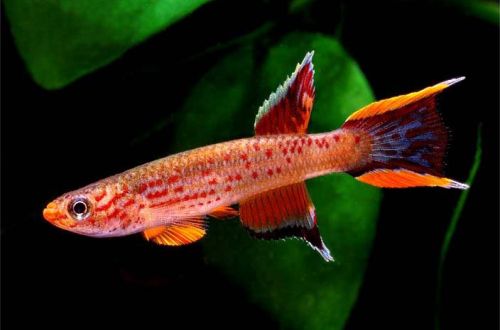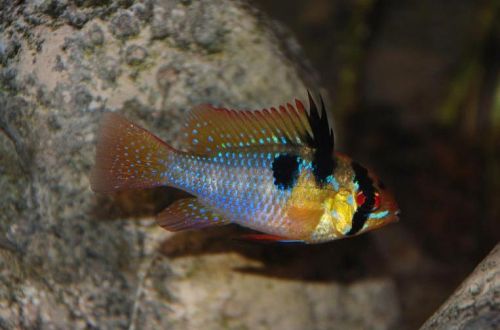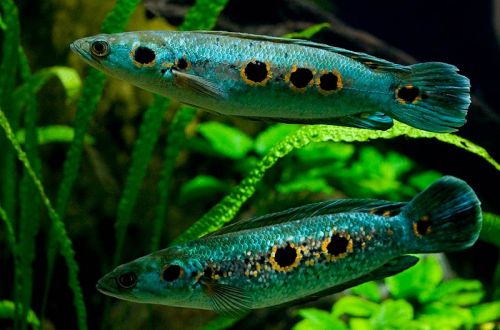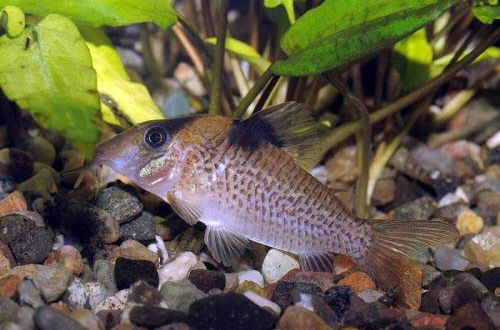
Afiosemion South
Aphiosemion Southern or “Golden Pheasant”, scientific name Aphyosemion australe, belongs to the Nothobranchiidae family. One of the first Killie fish to become popular in the aquarium trade: unpretentious, brightly colored, easy to breed and peaceful in disposition. This set of qualities makes it an excellent candidate for the role of the first fish of a novice aquarist.

Habitat
Afiosemion comes from stagnant or slow-flowing shallow water bodies, it is also found in river systems, but prefers to stick to the coastal part, where there is a lot of aquatic vegetation and a weak current. The distribution area is Western Africa (the equatorial part), the territory of modern Gabon, the mouth of the Ogove River, low-lying areas along the entire coast of the country.
Description
Narrow, low body with fins elongated and pointed at the ends. There are several color forms, the most famous and popular orange variety, called the “Golden Pheasant”. Males have a spotted pattern throughout the body of numerous bright specks, females look noticeably paler. The fins are colored in body color and have a white edging, the anal fin is additionally decorated with a dark stroke.
Food
This species has been successfully bred in the artificial environment of aquariums for a long time, therefore it has adapted to dry food (flakes, granules). However, the inclusion of protein foods (bloodworm, daphnia) in the diet is strongly recommended to maintain tone and bright color.
Maintenance and care
In an aquarium, it is desirable to recreate living conditions similar to the natural environment, namely: a sandy dark substrate with numerous shelters in the form of snags, intertwined roots and branches of trees, dense thickets of plants, including floating ones, they create additional shading.
Soft (dH parameter) slightly acidic or neutral (pH value) water is suitable for filling, similar parameters can be achieved by simply boiling, and over time, water becomes slightly acidic in any aquarium. Read more about pH and dH parameters in the section “Hydrochemical composition of water”.
Maintenance of Afiosemion South is not at all burdensome, it is necessary to regularly clean the soil and renew part of the water by 10–20%. In a large tank from 100 liters and with a powerful filtration system, cleaning and renewal can be carried out every 2-3 weeks, depending on the number of inhabitants. With smaller volumes, the frequency is reduced. The minimum required set of equipment includes a filter, aerator, heater and lighting system. When setting them up, keep in mind that the fish prefer a shaded aquarium and very little water movement.
Behavior
A calm, peaceful, accommodating fish, the terms shy and timid are quite applicable. Can be kept in pairs or in groups. As neighbors, species of similar temperament and size should be selected; active and even more aggressive species should be excluded.
Breeding
In a flock of fish, where male and female individuals are present, the appearance of offspring is very likely. No special conditions are required. During the spawning period, the male acquires a brighter intense color, and the female noticeably rounds off, filling with caviar. Eggs can be deposited in the general aquarium, but their safety is not guaranteed. Spawning is preferably carried out in a separate tank. When external signs of an imminent mating season appear, the couple moves to a spawning aquarium. A small container is enough, for example a three-liter jar. The Java moss substrate will be a great place for eggs. Of the equipment, only a heater, a filter, an aerator and a lighting system are required. Spawning takes place in the twilight, dragging on for a week or more, in one day the female lays up to 20 eggs. When everything is over, the couple is transferred back. All this time, do not forget to feed the future parents and carefully remove their waste products without touching the eggs.
The incubation period lasts up to 20 days, the fry appear in batches and begin to swim freely on the third day. Feed 2 times a day with microfood (Artemia nauplii, ciliates). Since there is no water purification system, it should be partially updated every three days.
Fish diseases
In favorable conditions and a balanced diet, health problems do not arise. The main sources of infection are poor environment, contact with sick fish, poor quality food. Read more about symptoms and treatments in the Aquarium Fish Diseases section.





